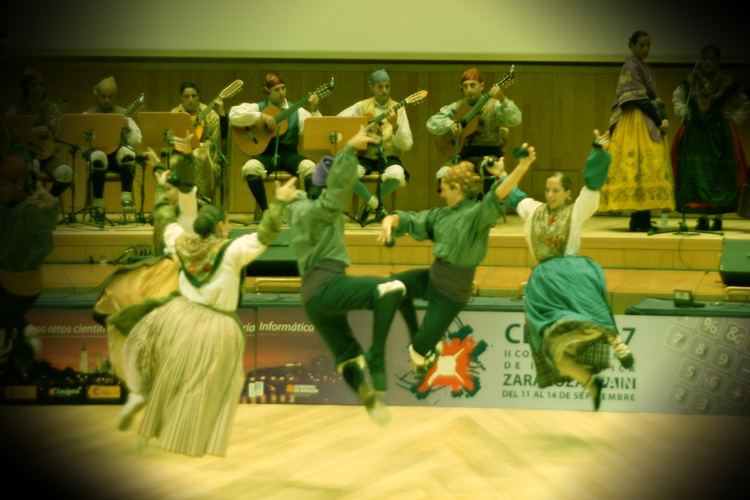 | ||
The jota ([ˈxota]; [ˈdʒɔta]; Aragonese: hota [ˈxota] or ixota [iˈʃota]; Asturian: xota [ˈʃota]; Galician: xota [ˈʃɔta]; old Spanish spelling: xota) is a genre of music and the associated dance known throughout Spain, most likely originating in Aragon. It varies by region, having a characteristic form in Aragon (where it is the most important), Catalonia, Castile, Navarre, Cantabria, Asturias, Galicia, La Rioja, Murcia and Eastern Andalusia. Being a visual representation, the jota is danced and sung accompanied by castanets, and the interpreters tend to wear regional costumes. In Valencia, the jota was once danced during interment ceremonies.
Contents
The jota tends to have a 3
4 rhythm, although some authors maintain that the 6
8 is better adapted to the poetic and choreographic structure. For their interpretation, guitars, bandurrias, lutes, dulzaina, and drums are used in the Castilian style, while the Galicians use bagpipes, drums, and bombos. Theatrical versions are sung and danced with regional costumes and castanets, though such things are not used when dancing the jota in less formal settings. The content of the songs is quite diverse, from patriotism to religion to sexual exploits. In addition to this, the songs also have the effect of helping to generate a sense of local identity and cohesion.
The steps have an appearance not unlike that of the waltz, though in the case of the jota, there is much more variation. Furthermore, the lyrics tend to be written in eight-syllable quartets, with assonance in the first and third verses.
Etymology
The medieval word "xiota" (pronounced [ˈʃota] or [ˈʃɔta]), derives from Mozarabic šáwta "jump", ultimately from Latin saltāre "to jump". Due to phonetic changes, it has become jota (pronounced [ˈxota]) in modern Spanish (reborrowed to Valencian as jota [ˈdʒɔta], or cota [ˈkɔta]) and hotia (pron. [ˈxota]) or ixota (pron. [iˈʃota]) in Aragonese.
The Aragonese Jota
The Aragonese Jota is the best-known expression of Aragonese folklore. It dates as far back as the 18th century, and reached the pinnacle of its splendor in the 19th century. Due to the complexities of the dance steps and manner of singing, the jota has evolved. Since the end of the 19th century, heavily choreographed versions have often been made for zarzuelas, movies, contests, festivals, and other entertainments. The most pure forms of the jota can still be found in Calanda, Alcañiz, Andorra, Albalate, and Zaragoza.
Nowadays there exist many modern varieties of the jota which are performed by various folkloric groups. Among the most popular can be found: Jota de San Lorenzo (Huesca), Jota Vieja, Aragón Tierra Bravía, Gigantes y Cabezudos, La Dolores (these last two are from zarzuelas of the same name), and the danza de la Olivera.
The Castilian Jota
As noted earlier, the jota of Castile tends to be accompanied by guitars, bandurrias, lutes, dulzaina and drums. As the music plays, the dancers dance with hands atop their heads, accompanied at times by castanets. The jota of Castile has a more sober, less airy feel to it, while the steps are quicker and sharper than what is seen in the Aragonese version. The songs accompanying the jota, which are known for their wry humor, typically deal with life, love, weddings, (often giving advice to the newlyweds) or religion.
The Philippine Jota
The Philippine Jota was among the most popular dances during the Spanish colonial period in the Philippines and up to the early 20th century. It was originally performed by Señoritas and Caballeros in social gatherings (like wedding, parties and baptismal) during the Spanish period in the Philippines. The Filipinos adapted this lively and delightful dance with different versions. These versions are combinations of Spanish and Filipino dance steps and music. Notable differences between the Philippine and Spanish jotas are the use of unstrung bamboo castanets. The jota is accompanied by the Philippine rondalla often consisting of a bandurria, guitar, bass and other mandolin-type instruments.
Variations of jotas differ from region to region. One such example is the Jota Paragua. The Jota Paragua came from Palawan’s old capital-Cuyo Islands displays a heavy Castilian influence. The zapateados (footwork), cubrados (curved arms), and Sevillana (flounced and ruffled) style of dress are evidently Spanish in origin. The ladies wave their mantón, or decorative shawl, while the gentlemen keep brisk pace with bamboo castanets. The music is an alternating fast and slow tempo similar to Spanish airs which accompany dances like the flamenco, jota, bolero, seguidilla and fandango.
Other examples of Philippine jotas are Jota Manileña from Manila, Jota Caviteña from Cavite and Jota Moncadeña from Tarlac.
Composers
Some composers, both Spanish and non-Spanish, have made use of the jota in various works:
